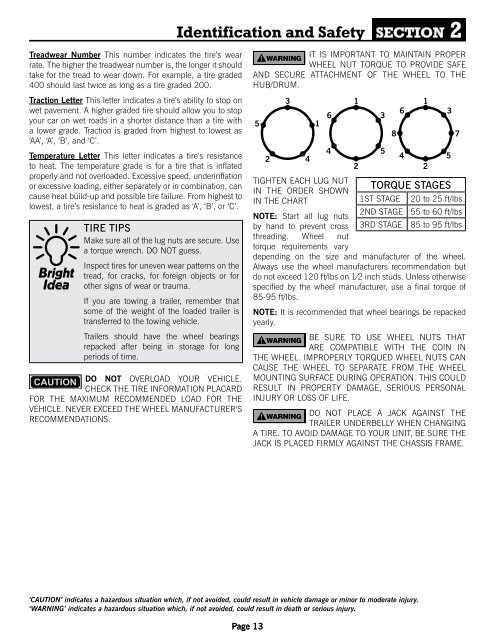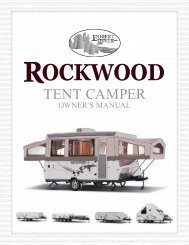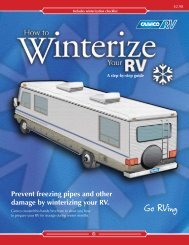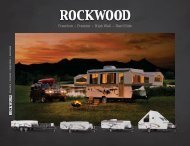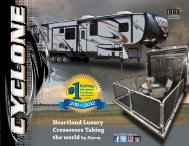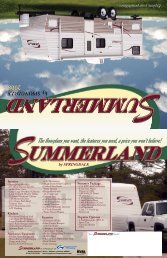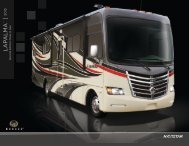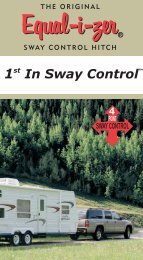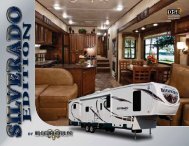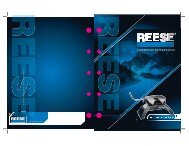Forest River Owners Manual - TTFW (PDF) - Pete's RV Center
Forest River Owners Manual - TTFW (PDF) - Pete's RV Center
Forest River Owners Manual - TTFW (PDF) - Pete's RV Center
Create successful ePaper yourself
Turn your PDF publications into a flip-book with our unique Google optimized e-Paper software.
Identification and Safety<br />
SECTION 2<br />
Treadwear Number This number indicates the tire’s wear<br />
rate. The higher the treadwear number is, the longer it should<br />
take for the tread to wear down. For example, a tire graded<br />
400 should last twice as long as a tire graded 200.<br />
Traction Letter This letter indicates a tire’s ability to stop on<br />
wet pavement. A higher graded tire should allow you to stop<br />
your car on wet roads in a shorter distance than a tire with<br />
a lower grade. Traction is graded from highest to lowest as<br />
‘AA’, ‘A’, ‘B’, and ‘C’.<br />
Temperature Letter This letter indicates a tire’s resistance<br />
to heat. The temperature grade is for a tire that is inflated<br />
properly and not overloaded. Excessive speed, underinflation<br />
or excessive loading, either separately or in combination, can<br />
cause heat build-up and possible tire failure. From highest to<br />
lowest, a tire’s resistance to heat is graded as ‘A’, ‘B’, or ‘C’.<br />
Bright<br />
Idea<br />
TIRE TIPS<br />
Make sure all of the lug nuts are secure. Use<br />
a torque wrench. DO NOT guess.<br />
Inspect tires for uneven wear patterns on the<br />
tread, for cracks, for foreign objects or for<br />
other signs of wear or trauma.<br />
If you are towing a trailer, remember that<br />
some of the weight of the loaded trailer is<br />
transferred to the towing vehicle.<br />
Trailers should have the wheel bearings<br />
repacked after being in storage for long<br />
periods of time.<br />
DO NOT OVERLOAD YOUR VEHICLE.<br />
CHECK THE TIRE INFORMATION PLACARD<br />
FOR THE MAXIMUM RECOMMENDED LOAD FOR THE<br />
VEHICLE. NEVER EXCEED THE WHEEL MANUFACTURER’S<br />
RECOMMENDATIONS.<br />
WARNING<br />
IT IS IMPORTANT TO MAINTAIN PROPER<br />
WHEEL NUT TORQUE TO PROVIDE SAFE<br />
AND SECURE ATTACHMENT OF THE WHEEL TO THE<br />
HUB/DRUM.<br />
3<br />
5 1<br />
2<br />
4<br />
1<br />
6 3<br />
4<br />
2<br />
TIGHTEN EACH LUG NUT<br />
TORQUE STAGES<br />
IN THE ORDER SHOWN<br />
IN THE CHART<br />
1ST STAGE 20 to 25 ft/lbs<br />
2ND STAGE 55 to 60 ft/lbs<br />
NOTE: Start all lug nuts<br />
by hand to prevent cross 3RD STAGE 85 to 95 ft/lbs<br />
threading. Wheel nut<br />
torque requirements vary<br />
depending on the size and manufacturer of the wheel.<br />
Always use the wheel manufacturers recommendation but<br />
do not exceed 120 ft/lbs on 1⁄2 inch studs. Unless otherwise<br />
specified by the wheel manufacturer, use a final torque of<br />
85-95 ft/lbs.<br />
NOTE: It is recommended that wheel bearings be repacked<br />
yearly.<br />
WARNING BE SURE TO USE WHEEL NUTS THAT<br />
ARE COMPATIBLE WITH THE COIN IN<br />
THE WHEEL. IMPROPERLY TORQUED WHEEL NUTS CAN<br />
CAUSE THE WHEEL TO SEPARATE FROM THE WHEEL<br />
MOUNTING SURFACE DURING OPERATION. THIS COULD<br />
RESULT IN PROPERTY DAMAGE, SERIOUS PERSONAL<br />
INJURY OR LOSS OF LIFE.<br />
WARNING DO NOT PLACE A JACK AGAINST THE<br />
TRAILER UNDERBELLY WHEN CHANGING<br />
A TIRE. TO AVOID DAMAGE TO YOUR UNIT, BE SURE THE<br />
JACK IS PLACED FIRMLY AGAINST THE CHASSIS FRAME.<br />
5<br />
8<br />
1<br />
6 3<br />
4 5<br />
2<br />
7<br />
‘CAUTION’ indicates a hazardous situation which, if not avoided, could result in vehicle damage or minor to moderate injury.<br />
‘WARNING’ indicates a hazardous situation which, if not avoided, could result in death or serious injury.<br />
Page 13


